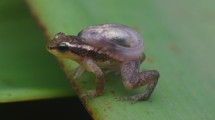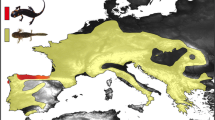Abstract
The decision how to allocate marginal resources to reproduction and growth can have important effects on associated life-history parameters as well as on population dynamics. In addition to showing variation among individuals in a population, such allocation rules may be either condition-dependent or fixed in different individuals. While many studies on anuran amphibians have focused on egg numbers and egg sizes in females of different sizes, virtually no data exist on the relative allocation of marginal resources to growth versus reproduction. In the laboratory, we therefore offered female common frogs (Rana temporaria) low versus high food rations for a full reproductive cycle, and monitored their growth and later reproductive investment (egg number and egg size the following breeding season). Feeding rates had an effect both on female growth and on egg number and size. There was no trade-off found between the two forms of investment. A flexible allocation rule could not be supported as there was no significant effect of feeding rate on the relative allocation of resources to growth versus reproduction.





Similar content being viewed by others
References
Bernardo J (1996) The particular maternal effect of propagule size, especially egg size: patterns models, quality of evidence and interpretations. Am Zool 36:216–236
Berven KA (1988) Factors affecting variation in reproductive traits within a population of wood frogs Rana sylvatica. Copeia 1988:605–615
Bonnet X, Bradshaw D, Shine R (1998) Capital versus income breeding: an ectothermic perspecive. Oikos 83:333–342
Brown GP, Shine R (2002) Reproductive ecology of a tropical natricine snake, Tropidonophis mairii (Colubridae). J Zool 258:63–72
Caley MJ, Schwarzkopf L, Shine R (2001) Does total reproductive effort evolve independently of offspring size? Evolution 55:1245–1248
Cichon M (1997) Evolution of longevity through optimal resource allocation. Proc R Soc Lond B Biol Sci 264:1383–1388
Cummins CP (1986) Temporal and spatial variation in egg size and fecundity in Rana temporaria. J Anim Ecol 55:303–316
Doughty P, Shine R (1997) Detecting life history trade-offs: measuring energy stores in “capital” breeders reveal costs of reproduction. Oecologia 110:508–513
Doughty P, Shine R (1998) Reproductive energy allocation and long-term energy stores in a viviparous lizard (Eulamprus tympanus). Ecology 79:1073–1083
Edwards A, Jones SM, Wapstra E (2002) Multiennial reproduction in females of a viviparous, temperate-zone skink, Tiliqua nigrolutea. Herpetologica 58:407–414
Gebhardt-Henrich SG, Heeb P, Richner H, Tripet F (1998) Does loss of mass during breeding correlate with reprouctive success? A study on blue tits Parus caeruleus. Ibis 140:210–213
Gelder JJ van (1995) Reproductive effort in Bufo bufo. Sci Herpetol 1995:176–179
Gibbons MM, McCarthy TK (1986) The reproductive output of frogs Rana temporaria (L.) with particular reference to body size and age. J Zool 209:579–593
Girish S, Saidapur SK (2000) Interrelationship between food availability, fat body, and ovarian cycles in the frog, Rana tigrina, with a discussion of the role of fat body in anuran reproduction. J Exp Zool 286:487–493
Grafen A (1988) On the uses of data on lifetime reproductive success. pp 454–471. In: Clutton-Brock TH (ed) Reproductive success. Studies of individual variation in contrasting breeding systems. University of Chicago Press, Chicago
Grossman GD, McDaniel K, Ratajczak RE Jr (2002) Demographic characteristics of female mottled sculpin, Cottus bairdi, in the Coweeta Creek drainage, North Carolina. Environ Biol Fish 63:299–308
Heino M, Kaitala V (1999) Evolution of resource allocation between growth and reproduction in animals with indeterminate growth. J Evol Biol 12:423–429
Hönig J (1966) Über Eizahlen von Rana temporaria. Salamandra 2:70–72
Ito K (1997) Egg-size and -number variations related to maternal size and age, and the relationship between egg size and larval characteristics in an annual marine gastropod, Haloa japonica (Opsithobrancia; Cephalaspidea). Mar Ecol Prog Ser 152:187–195
Ji X, Braña F (2000) Among clutch variation in reproductive output and egg size in the wall lizards (Podarcis muralis) from a lowland population of northern Spain. J Herpetol 34:54–60
Jokela J (1997) Optimal energy allocation tactics and indeterminate growth: Life history evolution of long-lived bivalves. In: Streit T, Städler T, Lively CM (eds) Evolutionary ecology of freshwater animals: concepts and case studies. Birkhäuser, Basel, pp179–196
Jokela J, Mutikainen P (1995) Phenotypic plasticity and priority rules for energy allocation in a freshwater clam: a field experiment. Oecologia 104:122–132
Joly P (1991) Variation in size and fecundity between neighbouring populations in the common frog Rana temporaria. Alytes 9:79–88
Jönsson KI (1997) Capital and income breeding as alternative tactics of resource use in reproduction. Oikos 78:57–66
Jörgensen CB (1981) Ovarian cycles in a temperate zone frog, Rana temporaria, with special reference to factors determining number and size of eggs. J Zool 195:449–458
Kaplan RH (1998) Maternal effects, developmental plasticity, and life history evolution. In: Mousseau TA, Fox CW (eds) Maternal effects as adaptations. Oxford University Press, Oxford, pp 244–260
Koslowska M (1971) Differences in the reproductive biology of mountain and lowland common frogs, Rana temporaria L. Acta Biol Cracov 14:17–32
Kozlowski J (1991) Optimal energy allocation models—an alternative to the concepts of reproductive effort and cost of reproduction. Acta Oecol 12:11–33
Kozlowski J (1996) Optimal allocation of resources explains interspecific life-history patterns in animals with indeterminate growth. Proc R Soc Lond B Biol Sci 263:559–566
Kyriakopoulos-Sklavounou P, Loumbourdis N (1990) Annual ovarian cycle in the frog, Rana ridibunda, in northern Greece. J Herpetol 24:185–191
Lardner B (2000) Phenotypic plasticity and local adaptation in tadpoles. PhD Dissertation, Lund University, Lund, Sweden
Loman J (1978) Growth of brown frogs Rana arvalis and Rana temporaria in south Sweden. Ekol Pol 269:287–296
Loman J (1990) Frog density and distribution in a heterogeneous landscape—a modelling approach. Ekológiia 9:353–360
Loman J (2001) Local variation in Rana temporaria egg and clutch size—adaptions to pond drying. Alytes 19:45–52
Loman J, Claesson D (2003) Plastic response to pond drying in tadpoles Rana temporaria: tests of cost models. Evol Ecol Res 5:179–194
Noordwijk AJ van, de Jong G (1986) Acquisition and allocation of resources: their influence and variation in life history tactics. Am Nat 128:137–142
Parker GA, Begon M (1986) Optimal eggsize and clutch size: effects of environment and maternal phenotype. Am Nat 128:573–592
Resetarits WJ Jr, Aldridge RD (1988) Reproductive biology of a cave-associated population of the frog Rana palustris. Can J Zool 66:329–333
Reyer H-U, Frei G, Som C (1999) Cryptic female choice: frogs reduce clutch size when amplexed by undesired males. Proc R Soc Lond B Biol Sci 266:2101–2107
Reznick D (1983) The structure of guppy life histories: the tradeoff between growth and reproduction. Ecology 64:862–873
Roff DA (1992) The evolution of life histories. Theory and analysis. Chapman and Hall, New York
Ryser J (1989) Weight loss, reproductive output, and the cost of reproduction in the common frog, Rana temporaria. Oecologia 78:264–268
Ryser J (1996) Comparative life histories of a low- and a high-elevation population of the common frog Rana temporaria. Amphibia-Reptilia 17:183–195
Schaffer WM (1974) Selection for optimal life histories: the effects of age structure. Ecology 55:291–303
Schneider JM, Lubin Y (1997) Does high adult mortality explain semelparity in the spider Stegodyphus lineatus (Eresidae)? Oikos 79:92–100
Schwarzkopf L (1993) Cost of reproduction in water skinks. Ecology 74:1970–1982
Seymour RS (1973) Energy metabolism of dormant spadefoot toads (Scaphiopus). Copeia 1973:435–445
Smith CC, Fretwell SD (1974) The optimal balance between size and number of offspring. Am Nat 108:499–506
Stearns SC (1992) The evolution of life histories. Oxford University Press, Oxford
Tejedo M (1992a) Absense of trade-off between the size and number of offspring in the natterjack toad (Bufo calamita). Oecologia 90:294–296
Tejedo M (1992b) Effects of body size and timing of reproduction on reproductive success in female natterjack toads (Bufo calamita). J Zool Lond 228:545–555
Winkler DW, Wallin K (1987) Offspring and number: a life history model linking effort per offspring and total effort. Am Nat 129:708–720
Worley AC, Houle D, Barrett SCH (2003) Consequences of hierarchial allocation for the evolution of life-history traits. Am Nat 161:153–167
Acknowledgements
The presentation has been improved by comments from K. Ingemar Jönson and Lars Råberg.
Author information
Authors and Affiliations
Corresponding author
Rights and permissions
About this article
Cite this article
Lardner, B., Loman, J. Growth or reproduction? Resource allocation by female frogs Rana temporaria . Oecologia 137, 541–546 (2003). https://doi.org/10.1007/s00442-003-1390-5
Received:
Accepted:
Published:
Issue Date:
DOI: https://doi.org/10.1007/s00442-003-1390-5




